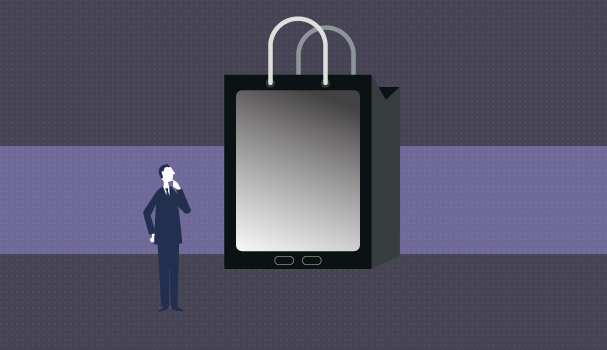Given the huge wealth of retailers operating online and endless discussions of bounce rates and AB testing, the modern e-commerce sector can seem like an incredibly intimidating space for the uninitiated. But, in actual fact, the barriers to entry have never been lower. “These days it’s extremely simple,” explains Carl Waldekranz, founder of Tictail, the e-commerce platform. Simple visual website design tools and a plethora of consumer-friendly e-commerce platforms mean that a small retailer can easily get online in no time at all. “These services make it simple to create a stunning online store in a matter of minutes without any prior technological knowledge,” adds Waldekranz.
Finding the right platform to get a store online couldn’t be easier. “The great thing is that there are now a lot of entry level platforms out there,” says David Brown, founder of Ve, the e-commerce conversion company. Simple website creation tools are a great place to start; easy-to-use website design platforms like Squarespace come with e-commerce products that can easily be slotted into your site in minutes. Once a retailer has a higher level of traffic and more than 40 or so products, pro tools like Shopify, Magento and PrestaShop are there to pick up the slack. “They now have offerings at all levels of business and they have a seamless way to upgrade the package that you’re on,” Brown continues. “You can upgrade and start moving through to limitless product lines and bandwidth.”
But don’t feel that you need to launch all guns blazing right from the off. Whilst it’s tempting to try to cram in every tool that you can find into your site, it’s worth starting small and only picking up additional tools when you’re sure you need them. “There’s a benefit to starting with a pad and paper or starting with Excel,” says Henry Morland, chief product officer at Brightpearl, the cloud-based business management application. “Get it right, work out what it is that you want to be doing, then you can see what you want to get from your tools.” The requirements of an online store will be entirely unique and the model that works for one store won’t necessarily work for the next. “You need to really understand what your business is doing and where you’re making your money, then you can come and put in place the tools that help you to drive that.”
Fortunately, the business model used by most e-commerce services are perfectly structured for this approach. Many tools are quick to install and function on a plug-and-play basis. “Let’s say you want to add a wishlist function to your site,” says Brown. “You can pay $40 – $50 a month, double-click and install it; all of a sudden all of your products appear with a wishlist logo behind them and allow customers to build a wishlist.” This makes it easy for online retailers to quickly and easily build in new functionality as and when they need, rather than needing to have everything nailed down long in advance.

E-commerce offerings need much more than just a website and some natty functions however. Without customers an online store is going nowhere.
Fortunately we live in an age when creating noise around a brand couldn’t be simpler. With a Twitter account, a Facebook page and a little gumption, a retailer fresh to the market can make a splash with surprising ease. “Be prolific, heavy on social media, heavy on strong position articles and blogs,” says Brown. “The busier you keep yourself on it the more noise you create.” Getting the ball rolling and a stream of products shipping out to customers doesn’t require a huge outlay for display ads; a start-up can invest time rather than capital and achieve remarkable results. “That’s the great thing about online retailers,” Brown continues. “There’s so much at your disposal and you don’t have to have a big marketing budget.”
But social media efforts shouldn’t just be about getting people to buy your wares. “People who buy from you and your brand don’t just buy a product; they buy into your company and into your story,” Waldekranz says. The most successful online retailers aren’t those that focus on flogging a product; they use tools like social media to involve consumers in the narrative of their business. “They invite you along on their journey of running a small business,” he explains.
Despite how easy it is to get a store off the ground, however, this is not to say that things don’t become more tricky as an e-commerce offering grows. Particularly when a retailer begins operating across multiple channels, having a clear oversight of what is happening at any given time is much harder. “That’s where lots of the detail of it becomes quite difficult,” says Morland. “It’s fine when you are just taking a couple of orders but very quickly you find yourself juggling online orders and orders from other channels.”
Ultimately, the make or break of an online store is likely to be how efficiently it manages its customer journey, ensuring the highest number of consumers convert to sales. “There are so many challenges in terms of optimisation and conversion,” says Brown. Online retailers lose customers for all sorts of reasons, whether they be bugs in the site, credit card issues or a better deal elsewhere. “If you don’t look at the conversion strategy around what happens to the traffic that arrives at your site, you’re kind of just wasting all of your efforts,” he says.
This is where analytics go from being something rather alien to being an online retailer’s best friend, helping them get a clear handle on what’s happening under their noses. When online retailers are struggling to know how a particular line is working for them and whether there are ways to maximise the returns it offers, bringing in various trackers and analytics can help them make smart decisions about their business. “They give you much more granular control over what you’ve got, how quickly you can turn your stock and therefore how you’re making your investment work for you,” Morland explains.
But while it’s important to have an idea of how you’re going to grow your offering, for online retailers at the beginning of their journey the best bet is to get moving. “In this very complex market, it’s almost impossible to know anything from the get go,” says Waldekranz. Fortunately, the adaptability of the tools on offer mean that its very easy for e-commerce offerings to experiment with what works and adapt depending on what they’ve learnt. So rather than hanging about until you have your trajectory perfectly plotted, be bold and get going. “The more time that you spend planning, the more wrong you’re going to be,” he concludes. “If you’re considering starting an online business, why don’t you start it today?”

Making green
My Green Bag
My Green Bag, the ethical bag store, was born out of founder Mahamood Raihan’s experience manufacturing products for other brands out of greener, sustainable materials. Gradually, he wanted to start designing his own lines and began to produce bags out of green materials, such as jute and untreated leather. Launching an online store was a natural step for My Green Bag; using web design tool Yola and a little technical knowledge Raihan launched his store in 2012.
It didn’t take long for the store to begin to gain some serious traction. “In the second year, we’d done more than three times the sales of our first year because we got featured by a lot of bloggers, we’d been featured by a lot of magazines like Elle,” Raihan says. Alongside these organic sales, the online retailer started boosting its profile with ads on Twitter and Facebook and social media activity on Tumblr and Instagram. This has paid real dividends; not only is the start-up listed on ASOS but in October it became a featured boutique.
But, for MyGreenBag, there’s no resting on its laurels. Not only is the site due a redesign to introduce more interactive content but the brand has its eye on developing its partnerships with other retailers. “We’re currently in talks with ASOS about creating some products together,” Raihan says. The ethical bag maker is also eyeing up ways to boost its profile and distribution; it’s angling for a spot on Etsy and is trying to form contacts with more movers and shakers on social media. “As a brand our main target is to collaborate more with influential people and influential brands,” Raihan says. “That’s our main marketing plan for the next year.” ![]()
Share via:








































